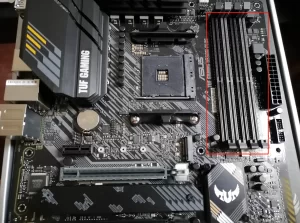Building a computer can be a fun but challenging experience, and one of the most difficult parts is getting your RAM configuration just right for optimal performance. Most PC component stores sell RAM chips in packs of two, and we’ve all heard of dual-channel RAM. But what if you have three identical RAM chips that you want to combine? Will the computer run properly?
You can use as many RAM chips as your motherboard will support, especially if the chips are identical. You probably won’t experience any problems, depending on the computer manufacturer. But you may not have optimal performance, as pairing similar RAM chips enable dual-channel mode for more speed.
RAM chips and how motherboards interact with them can get complicated. Some motherboard brands don’t allow RAM configurations that others use without issues. Let’s examine the pros and cons of using three identical RAM sticks on your computer.
Related reading: Do You Get Better Performance With 2 Or 4 RAM Sticks?
Is it OK to use 3 Sticks of RAM?
Using three sticks of RAM in a computer is technically possible, but it has some considerations:
- Dual-Channel Mode: Most modern motherboards support dual-channel memory, which is optimized for equal memory sticks in paired slots. Using three sticks might cause the system to run in single-channel mode or a mixed mode, potentially reducing performance.
- Capacity and Compatibility: If the total capacity and speed of the three sticks meet your needs, and they are compatible with your motherboard, you can use them. Ensure that the RAM sticks have similar specifications for optimal performance.
You may also like: Can I Use DDR5 RAM on DDR4 Motherboard? - Asymmetrical Configuration: This setup is less common and may not be optimized in terms of performance compared to using symmetrical pairs of RAM sticks.
- System and BIOS/UEFI: Some systems and their BIOS/UEFI settings handle asymmetrical RAM configurations better than others. It’s worth checking your system’s documentation or manufacturer support for specific advice.
How to Install 3 Sticks of RAM?

Installing three sticks of RAM is an uncommon configuration since dual-channel motherboards (which are the most common type) work best with RAM in pairs. However, it can still be done. Here are the steps:
- Turn off your computer and disconnect it from the power source: This is a safety measure to prevent any accidental shocks.
- Open your computer’s case: Depending on your computer, you may need a screwdriver for this. Always handle your PC parts carefully to avoid damaging them.
- Locate the RAM slots on your motherboard: These will be long, thin slots. Most motherboards have 4 slots, labeled as A1, A2, B1, B2 or similar.
How should 3 Sticks of RAM be Placed?
- Install the RAM sticks: Open the clips on each end of the RAM slots. Take your first RAM stick and line up the notches on the stick with the ridges in the slot, then push it down firmly until the clips at the end of the slot snap into place. Repeat this process for the other RAM sticks. If you are installing 3 RAM sticks, you should fill A1, A2, and B1 (or equivalent slots) leaving B2 (or the equivalent slot) empty. This would result in a single channel operation.
- Close your computer’s case: Once the RAM sticks are installed, close your computer’s case, plug it back into the power source, and turn it on.
You may also like: Why Won’t Computer Start After Installing New RAM? - Check to see if your computer recognizes the new RAM: You can do this by opening the System Properties (Windows + Pause/Break key) in Windows or checking “About This Mac” on an Apple computer.
Remember, although installing 3 sticks of RAM is possible, it may not give you optimal performance. It’s usually best to install RAM in matching pairs for a dual-channel configuration. For the best results, always refer to your motherboard’s manual for specific instructions regarding memory configurations.
Will 3 RAM Sticks Work in Dual Channel?
In most scenarios, using three RAM sticks will not enable dual-channel architecture. Dual-channel architecture requires RAM sticks to be installed in pairs with equivalent capacity, speed, and timings, which then are placed into matching slots on the motherboard.
If you install three RAM sticks, the motherboard will typically run the system in single-channel mode for all three sticks, or alternatively, use dual-channel mode for the first pair and single channel for the remaining stick. The exact behaviour depends on your specific motherboard’s configuration and how it’s set up to handle mismatched or uneven RAM quantities.
As a result, using three RAM sticks might not provide optimal performance as compared to two or four matching RAM sticks running in dual-channel mode. However, if you’re looking for a quick capacity upgrade and have an extra stick lying around, adding a third stick can still provide a performance boost in terms of total available memory. Just remember that you might not be fully utilising your motherboard’s memory bandwidth capability.
Can I Use 3 RAM Sticks Instead of 4 RAM?
Yes, you can use 3 RAM sticks instead of 4, but there are a few things to consider:
- Memory Channel Configuration: Most motherboards support dual-channel memory configurations. Using three sticks may cause the system to run in a non-optimal configuration, like single-channel mode, which can slightly reduce overall memory bandwidth and performance.
- Compatibility: Ensure that the RAM sticks are compatible with your motherboard in terms of type (e.g., DDR4), speed, and voltage.
- Asymmetric Configuration: While using an asymmetric configuration (like 3 sticks) won’t generally harm your computer, it may not utilize the full potential of your system’s memory capabilities compared to using symmetric configurations (like 2 or 4 sticks).
- Total Capacity: If the total RAM capacity meets your needs, using three sticks is fine. For instance, if you require 24GB and each stick is 8GB, then three sticks are a viable option.
In summary, while you can use three RAM sticks, it’s generally more efficient to use RAM in pairs (2 or 4 sticks) to fully benefit from dual-channel configurations for better performance.
Can I Use 3 Sticks of 8GB RAM?
Yes, you can use three 8GB RAM sticks in your computer. However, how well this configuration will work can depend on the specifics of your computer system, particularly your motherboard.
Many desktop motherboards support dual-channel memory architecture. In a dual-channel configuration, the computer can access two RAM modules simultaneously, effectively doubling the memory bandwidth and improving performance. For this reason, RAM is often installed in pairs.
If you insert three RAM sticks, the first two will run in dual-channel mode, while the third will run in single-channel mode. This can still provide a boost to your total available memory, which can be beneficial for certain memory-intensive tasks. However, the third stick will not be as fast as the two running in dual-channel mode.
Will Three RAM Chips Always Work?
Not all motherboard manufacturers support such mix-and-match configurations, and some brands are even fussy about which brands of RAM they accept. Particularly Asus, MSI, and Dell are notorious for this, not to mention Apple (though most modern Apple computers don’t even have upgradeable RAM, to begin with).
If you want to try and use three RAM identical RAM chips in your computer, do the following:
- Check the manufacturer’s website for information about the supported RAM brands and configurations for your motherboard model.
- Try it. It won’t do any harm (if you do the installation correctly); if it doesn’t work, you can simply remove the third RAM chip.

